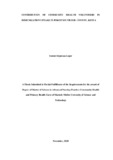CONTRIBUTION OF COMMUNITY HEALTH VOLUNTEERSIN IMMUNIZATION UPTAKE IN POKOT SOUTH SUB-COUNTY, KENYA
Abstract
Community Health Volunteers are key in increasing immunizations uptake. In Kenya, KDHS 2014 report indicates basicvaccination coverage reduced from 77%in 2008 to 71% in 2014 and the proportion of children who are fully immunized in West Pokot is only 31%. Little is known about the contribution of CHVsin uptakeof immunization servicesin Kenya and Pokot South, Sub-County is not anexception. This study, therefore, sought to determine the contribution of CHVs in the uptakeof immunization services in Pokot South, Sub-County of West Pokot County. A cross-sectional research design using mixed methods of data collectionwas adopted targeting CHVs and the households served in the community units. The study employed multi-stage sampling method to select villages, community units and the households that were randomly sampled. The sample size calculation was based on Yamane’s formula (1967)with resultant total of 184 CHVs and 356 caregivers who took part in the study. Data was collected using structured questionnaires for quantitative data and key informant interview schedules for qualitative data. Quantitative data was analyzed using SPSS Version 21.0.Chances proportions with 95% confidence interval were calculated to test the noteworthiness of affiliation between each independent and the dependent variable. P value ≤ 0.05 was considered statistically critical. Qualitative data was prepared by analyzing themes from key source interviews. The information from the two methods wastriangulated into a single document. CHVs respondents comprised 67.4% males and 32.6% females. Mean age was 37.6 and ranged between 23 to 63 years. Majority (96.2%) were married with nearly two thirds (64.1%) having attained primary education. The results revealed that CHVs who were supervised by CHEWs were 4.5 times more likely to have performed better (OR: 4.5; 95%CI: 1.5 –13.7; p = 0.01). Similarly, those who agreed that they had been supervised were four times more likely to have had better performance than those who were not (OR: 4.0; 95%CI: 1.3 –12.0; p = 0.02). This study highlighted that training is an important factor affecting the CHVs’ services. Households that were visited by CHVs were 1.7 times more likely to have had fully immunized children than those that were not (OR: 1.7; 95% CI: 1.1 –2.8; p = 0.03). The same was true where caregivers stated that CHV discussed vaccine preventable diseases during household visits (OR: 1.6; 95%CI: 1.0 –2.5; p = 0.05).In conclusion, CHVs play a major role in under-five immunization uptake. They act as link to households, communities and the health facilitiesand share health messages, trace defaulters,among other roles.The year when recruitedand regularsupervision by CHEWs are key factors that improve performance in the sub-county. Community has positive perception on contributions of CHVs in the study area as they are recognize and value the work they do. This study recommends further strengthening of partnership between health facilities and CHVs. There is need for the MOH to adherence to the recommended number of days for targeted and continuous training for CHVsand improvement in quality supervision and monitoringof CHVs by MOH and CHEWs. Based on perceptions on CHVs contribution on immunization, the Community Health Committees (CHC) there is need to look for ways on how to recognize and support CHV to motivate them.

